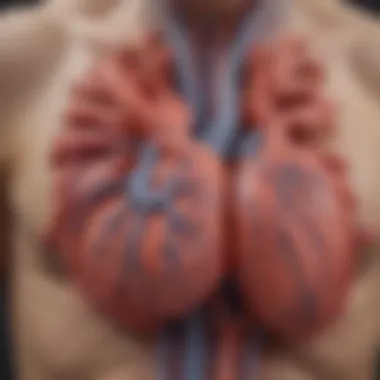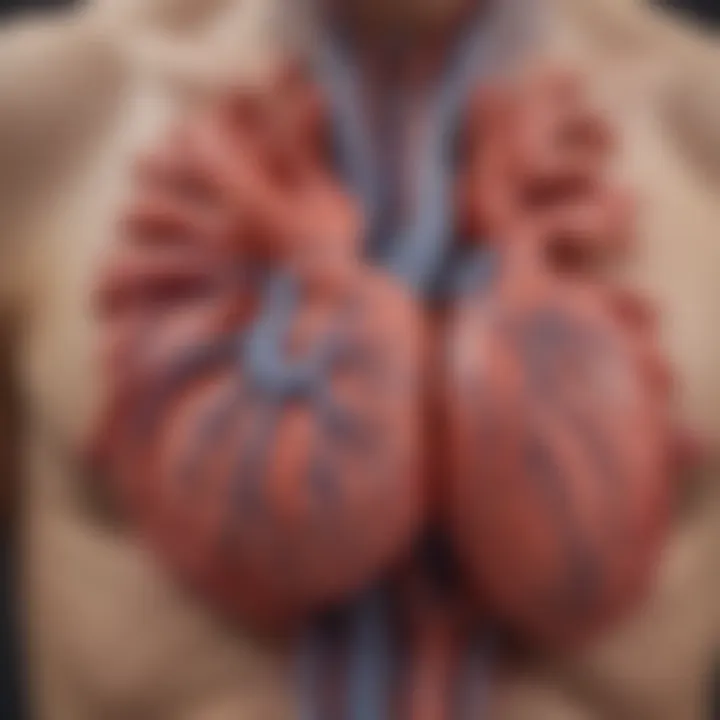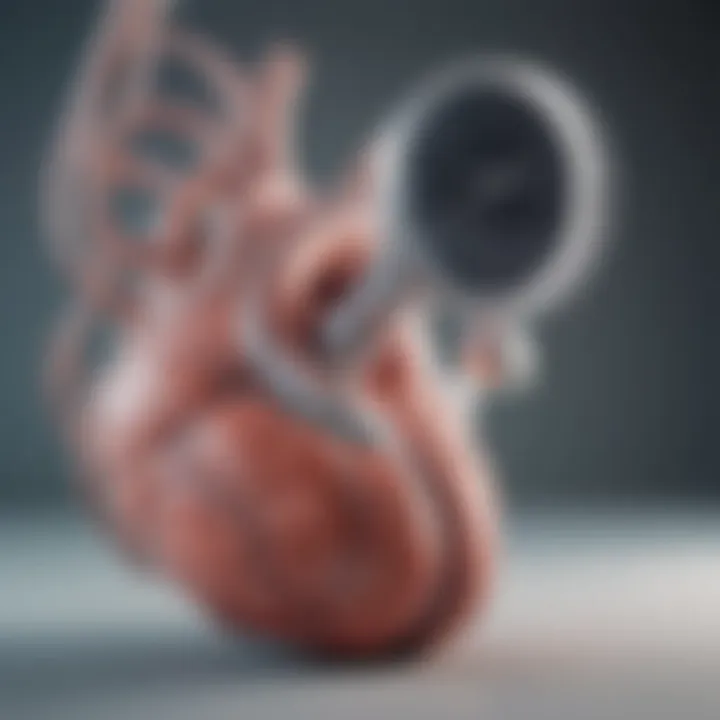Understanding Atrial Fibrillation and Pulmonary Veins


Intro
Atrial fibrillation (AF) has emerged as a focal concern in modern cardiology due to its widespread prevalence and potential to lead to severe complications, such as stroke and heart failure. This arrhythmia originates from chaotic electrical impulses in the atria, disrupting the synchronized contraction of the heart. Understanding the underlying mechanisms of AF requires a deep dive into various factors, including the anatomical and physiological roles of the pulmonary veins.
The pulmonary veins serve as conduits between the lungs and the heart, facilitating oxygen-rich blood transportation. These veins are not merely structural features; they actively participate in the electrical activities of the heart, influencing AF's initiation and maintenance. Therefore, establishing a comprehensive understanding of atrial fibrillation cannot be achieved without examining the dynamics of the pulmonary veins.
This article will systematically explore the relationship between atrial fibrillation and pulmonary vein anatomy, unraveling the mechanisms behind their intricate connection. The aim is to provide insights into diagnostic methodologies, contemporary treatments, and the importance of recognizing this connection in clinical practices for healthcare professionals and students alike.
Article Overview
Summary of Key Findings
The key findings of this article illuminate the role of pulmonary veins in the pathophysiology of atrial fibrillation. By discussing the distinct electrical characteristics of pulmonary veins and how they contribute to arrhythmias, this narrative uncovers critical insights that could potentially influence therapeutic approaches. We will also delve into current diagnostic tools that track AF and dissect emerging treatment strategies aimed at mitigating the risks associated with this arrhythmia.
Research Objectives
The primary objectives of the research include:
- Analyzing the anatomical significance of the pulmonary veins in relation to atrial fibrillation.
- .Examining the mechanisms through which atrial fibrillation is influenced by pulmonary vein activity.
- Evaluating contemporary diagnostic approaches employed in diagnosing AF and understanding pulmonary vein involvement.
- Discussing the latest therapeutic strategies designed to manage atrial fibrillation effectively.
In essence, this article seeks to augment existing knowledge on atrial fibrillation and pulmonary vein functionality, presenting information that is vital for advancing both research and clinical practices.
Prelude to Atrial Fibrillation
Atrial fibrillation is a complex condition that warrants in-depth exploration. The condition challenges not only the patient's health but also the healthcare system as a whole. It can lead to severe complications, including stroke and heart failure. Thus, understanding atrial fibrillation and how it operates within the heart's anatomy is crucial for both treatment and prevention.
In this section, we outline the fundamental aspects of atrial fibrillation, elucidating its definition and clinical relevance. Furthermore, we delve into its epidemiological data, emphasizing the prevalence and risk factors associated with this arrhythmia. Recognizing these elements is essential for healthcare professionals and students, as it lays the groundwork for more intricate discussions about the role of pulmonary veins, pathophysiology, and treatment options.
Definition and Clinical Significance
Atrial fibrillation is defined as an irregular and often rapid heart rate that can lead to poor blood flow. Unlike normal heart rhythm, which is coordinated and steady, atrial fibrillation results from chaotic electrical impulses. The condition can manifest in episodes that may resolve spontaneously or become persistent, leading to chronic symptoms.
The clinical significance of atrial fibrillation is profound. It increases the risk of several complications such as:
- Stroke: Atrial fibrillation heightens the likelihood of blood clots forming in the heart, potentially traveling to the brain. This risk necessitates close management of patients with AF.
- Heart Failure: The rapid heart rates can weaken the heart muscle over time, leading to heart failure.
- Quality of Life: Patients often experience symptoms like palpitations, fatigue, and dizziness, impacting daily activities and overall well-being.
Given its implications, atrial fibrillation is a considerable focus area in cardiology. Proper management is essential for improving patient outcomes.
Epidemiology of Atrial Fibrillation
The epidemiological landscape of atrial fibrillation underscores its prevalence and impact across diverse populations. According to recent data, the incidence of atrial fibrillation increases with age, making it a common condition in the elderly.
Key epidemiological findings include:
- AF affects around 1-2% of the general population. However, this number significantly rises in individuals aged over 65 years, with estimates reaching as high as 10% in this age group.
- Risk factors include hypertension, diabetes, obesity, and a history of heart disease. Studies also suggest that lifestyle factors such as excessive alcohol consumption and physical inactivity contribute to the development of AF.
- Geographic variations exist, with certain regions reporting higher prevalence due to genetic and environmental factors.
Understanding these epidemiological factors is vital for healthcare providers. It aids in early identification, risk assessment, and the development of effective preventative measures.
Anatomy of the Pulmonary Veins
The anatomy of the pulmonary veins represents a crucial element in the understanding of atrial fibrillation (AF). These veins are responsible for returning oxygenated blood from the lungs to the heart's left atrium. Anatomically, the four pulmonary veins originate from capillary networks within the lungs before merging into two pairs that drain into the left atrium. Their structure is essential not only for blood circulation but also in the pathophysiology of atrial fibrillation.
The structural intricacies of the pulmonary veins can directly influence cardiac rhythm. Variations in their anatomical features may play a role in the initiation and perpetuation of AF. An understanding of these structures can aid in recognizing predispositions to AF and tailoring appropriate treatment strategies for patients. This section will explore the structure and function of pulmonary veins, as well as their anatomical variations.
Structure and Function
The structure of the pulmonary veins is optimized for their role in transporting large volumes of oxygen-rich blood from the lungs to the heart. Each pulmonary vein lacks valves, allowing for unimpeded blood flow. Their walls are made up primarily of elastic fibers and smooth muscle, facilitating changes in diameter based on blood pressure and volume changes.
This adaptability is vital during physical exertion when the heart demands more oxygenated blood. The pulmonary veins also contain specialized cells that can influence heart rhythm and contribute to arrhythmias. The close relationship between the left atrium and pulmonary veins is particularly relevant as it allows for the spread of electrical impulses that may induce AF. Understanding this intricate structure of pulmonary veins aids medical professionals in diagnosing and managing atrial fibrillation effectively.
Pulmonary Vein Variations
Notably, the anatomy of the pulmonary veins can exhibit variations that significantly impact their function and the risk of developing atrial fibrillation. Variations can include the number of veins, their anatomical positions, and even the drainage patterns into the left atrium.


For instance, some individuals may possess an accessory pulmonary vein, which adds complexity to the circulatory dynamics. Such variations are associated with an increased susceptibility to atrial fibrillation due to altered electrical conduction and potential triggers for arrhythmias.
Recognizing these variations through imaging techniques can serve as a crucial diagnostic tool.
"Anatomical variations of the pulmonary veins are often overlooked but play a key role in understanding patient-specific risks for atrial fibrillation."
Pathophysiology of Atrial Fibrillation
Understanding the pathophysiology of atrial fibrillation (AF) is crucial for both diagnosis and treatment. Atrial fibrillation is a complex disorder characterized by irregular electrical activity in the atria. This irregularity leads to ineffective atrial contractions and is associated with various risk factors such as hypertension, heart disease, and diabetes. By grasping the underlying mechanisms of this condition, clinicians can better tailor therapies to manage symptoms and reduce associated risks, such as stroke and heart failure.
Electrophysiological Mechanisms
The electrophysiological mechanisms of atrial fibrillation involve multiple factors. At the cellular level, changes in ion channel function and calcium handling can contribute to abnormal automaticity and triggered activity. This results in chaotic electrical signals that propagate through the atrial tissue.
Key components that play a role include:
- Electrical remodeling: Prolonged AF can induce structural and functional electrical changes in atrial tissue, making it more susceptible to further episodes.
- Fibrosis: The presence of fibrosis disrupts normal conduction pathways, creating a substrate for AF.
- Triggers: Ectopic foci, often originating from the pulmonary veins, can initiate AF episodes by discharging irregular electrical impulses that stimulate atrial tissue.
Research indicates that changes in interstitial fibrosis can predispose individuals to AF by enhancing the reentrant circuits necessary for sustaining arrhythmia. Understanding these mechanisms allows for targeted approaches in patient care.
Role of Pulmonary Veins in AF Initiation
The pulmonary veins are critical in the initiation and perpetuation of atrial fibrillation. These veins are the primary source of ectopic foci that can trigger AF. The triggers often arise from the muscle sleeves located at the junction of the pulmonary veins and the left atrium.
The significance of these veins includes:
- Anatomical proximity: The physical structure of the pulmonary veins allows electrical signals to easily influence atrial tissue.
- Pulmonary vein isolation: Catheter ablation techniques are aimed at isolating these veins to prevent them from initiating AF. This strategy has become a common approach to manage AF in patients.
- Ectopic activity: The hyperactivity of cells within the pulmonary veins can lead to spontaneous discharges that propagate through the left atrium, resulting in AF episodes.
"The role of the pulmonary veins in atrial fibrillation initiation is pivotal, highlighting the need for precise diagnostic strategies to identify ectopic activity."
Clinical Manifestations of Atrial Fibrillation
Atrial fibrillation (AF) can present with various clinical manifestations that play a critical role in the diagnosis and management of the condition. Understanding these manifestations is essential for both clinicians and patients. Symptoms can vary greatly, leading to potential misinterpretation and consequences if left untreated. This section discusses the symptoms associated with AF and the complications that can arise from untreated cases, highlighting the importance of early recognition and intervention.
Symptoms Associated with Atrial Fibrillation
The symptoms of atrial fibrillation can range from mild to severe, significantly influencing patient quality of life. Some individuals may experience palpitations, which are often described as a fluttering or racing sensation in the chest. Others report fatigue or weakness, particularly during physical activity.
Additional common symptoms include:
- Shortness of breath: This may occur at rest or during exertion, affecting daily activities.
- Dizziness or lightheadedness: Patients often feel faint, especially when standing up quickly.
- Chest pain or discomfort: Although this is less common, it can present in individuals with AF.
It is crucial to recognize that some patients may be asymptomatic, even when presenting with AF on an electrocardiogram. The absence of symptoms does not mitigate the risk associated with the condition, including stroke and heart failure.
Early identification of symptoms can lead to timely intervention and management, reducing the risk of serious complications.
Complications of Untreated AF
Leaving atrial fibrillation untreated can result in severe health risks. The most significant concern is the increased likelihood of stroke. In AF, blood may pool in the atria, leading to clot formation. If a clot dislodges, it can travel to the brain, causing a stroke. The risk of stroke increases fivefold in patients with AF compared to those in normal rhythm.
Additional complications include:
- Heart failure: Persistent rapid heart rates can weaken the heart muscle, leading to congestive heart failure or worsening of pre-existing heart conditions.
- Diminished quality of life: The unpredictability of AF symptoms can limit an individual’s physical activities, social interactions, and overall wellbeing.
In summary, recognizing the clinical manifestations of atrial fibrillation is vital for effective management. Symptoms can vary widely, and the potential complications of untreated AF make it imperative to understand and address these signs promptly. Monitoring and addressing these elements can significantly improve outcomes for patients.
Diagnosis of Atrial Fibrillation
Diagnosing atrial fibrillation (AF) is a critical step in managing this common arrhythmia. Early and accurate diagnosis is vital because it directly influences treatment choices, patient outcomes, and overall heart health. Understanding the nuances of AF diagnosis allows clinicians to implement timely interventions that can mitigate the risks associated with this condition, particularly the possibility of stroke.
There are specific elements that contribute to the effective diagnosis of atrial fibrillation. Initially, a thorough patient history is taken, focusing on symptoms such as palpitations, dizziness, or fatigue. A physical examination typically accompanies this process to assess for signs of heart failure or other complications.
Electrocardiogram Findings
The electrocardiogram (ECG) stands as the cornerstone of AF diagnosis. An ECG records the electrical activity of the heart, and it can reveal characteristic patterns associated with atrial fibrillation. The typical findings include:


- Irregularly Irregular Rhythm: One of the most identifiable signs of AF.
- Absence of P Waves: Instead, there are fibrillatory waves that typically appear between the QRS complexes.
- Variable R-R Intervals: This refers to the unpredictability in the timing of heartbeats as seen on the ECG.
These findings not only confirm the presence of AF but also help to determine the urgency of treatment, especially in patients with significant symptoms or underlying heart conditions. Moreover, continual or Holter ECG monitoring may be necessary for patients with intermittent AF to capture episodes that might not occur during a standard ECG.
Advanced Imaging Techniques
In some cases, additional imaging techniques are required to enhance diagnosis and inform treatment strategies. Several advanced modalities provide valuable information about heart structure and function. These include:
- Echocardiography: This ultrasound examination offers insights into cardiac chamber sizes, ventricular function, and the presence of valvular heart disease.
- Cardiac MRI: Provides detailed images of the heart and may help identify substrate for AF.
- CT angiography: Occasionally used to visualize pulmonary veins, helping identify structural abnormalities.
Advanced imaging not only supports the diagnosis of atrial fibrillation but also assists in evaluating underlying conditions that may contribute to its development and persistence. As technology develops, the integration of these imaging techniques promises better patient management practices.
Accurate diagnosis of atrial fibrillation is indispensable, as it allows for the formulation of an effective treatment plan, ultimately improving patient outcomes and minimizing risks.
In summary, diagnosing atrial fibrillation is multi-faceted, involving patient history, ECG interpretation, and possibly advanced imaging techniques. The careful assessment of these elements is integral for proper management and treatment of the condition.
Therapeutic Approaches to Atrial Fibrillation
Managing atrial fibrillation effectively requires a nuanced approach, recognizing that this condition significantly varies between individuals. The therapeutic strategies aim to balance symptom relief with the prevention of complications, particularly stroke and heart failure. A comprehensive understanding of rate and rhythm control strategies is essential. Each method holds its unique advantages and considerations, necessary for tailoring treatment to individual patient needs.
Rate Control Strategies
Rate control strategies focus on managing the heart rate rather than restoring normal rhythm. This approach can be particularly effective for patients who are asymptomatic from AF or those for whom rhythm control has not been successful.
Common medications include:
- Beta-blockers: such as metoprolol and atenolol, reduce the heart rate by blocking adrenaline effects.
- Calcium channel blockers: like diltiazem and verapamil, help in controlling heart rate by inhibiting calcium entry into cardiac cells.
- Digoxin: often used in combination with other drugs, it strengthens heart contractions and provides rate control, especially in sedentary patients.
The primary benefit of rate control is the minimization of symptoms associated with tachycardia, thereby improving overall quality of life. However, challenges remain. For instance, patients can still experience complications associated with AF even if their heart rate is controlled, and continuous monitoring is necessary.
Rhythm Control Strategies
Rhythm control strategies aim to restore and maintain normal heart rhythm. This is particularly important for patients with severe symptoms or those at increased risk of complications.
Rhythm control may involve:
- Antiarrhythmic medications: such as amiodarone, sotalol, or flecainide, designed to stabilize the heart's electrical activity. These medications aim to restore normal sinus rhythm but come with their own set of potential side effects.
- Cardioversion: a electric shock can be delivered to the heart to restore normal rhythm, particularly useful in acute settings.
- Catheter ablation: a procedure that targets areas in the heart responsible for AF. This is often considered when medications or cardioversion fail.
While rhythm control strategies can be highly effective, they also require careful consideration. For instance, these methods may possess higher risks of complications compared to rate control. Moreover, monitoring is critical, as arrhythmias can recur, necessitating retreatment.
Ultimately, a well-rounded approach to atrial fibrillation incorporates both rate and rhythm control. The choice between these strategies will depend heavily on patient-specific factors such as symptom severity, comorbid conditions, and responses to previous treatments.
"An individualized strategy is crucial in the management of atrial fibrillation to optimize outcomes."
Understanding these approaches is key to engaging with patients about their treatment options. A tailored approach increases the likelihood of satisfactory results and enhances the overall patient experience.
Catheter Ablation and the Role of Pulmonary Veins
Catheter ablation serves as a pivotal treatment strategy for managing atrial fibrillation (AF). It targets specific areas of the heart responsible for triggering AF, particularly the pulmonary veins. Understanding the intricate interplay between catheter ablation procedures and the anatomical features of the pulmonary veins is essential for comprehending their role in this therapeutic approach. This section discusses why catheter ablation is significant in the treatment of AF and elaborates on its benefits and challenges.
Indications for Catheter Ablation
Catheter ablation is typically indicated for patients with symptomatic AF who do not respond adequately to antiarrhythmic medications. Several key factors inform this decision:
- Persistent Symptoms: Individuals experiencing recurrent palpitations, fatigue, or shortness of breath may desire more definitive treatment.
- Ineffectiveness of Medications: Some patients do not achieve satisfactory control of symptoms with drugs like amiodarone or Dronedarone, making ablation a suitable alternative.
- Heart Failure: Patients with coexisting heart failure often benefit from catheter ablation, as restoring normal rhythm can enhance overall heart function.
- Young Age: Younger patients, especially those with a history of AF, may opt for ablation earlier to preserve quality of life and long-term heart health.
These indications highlight the necessity for individualized treatment plans. Each case requires careful consideration of the patient's history, overall health, and preferences.
Ablation Techniques Targeting Pulmonary Veins
Several techniques are utilized in catheter ablation to effectively target the pulmonary veins. The two primary methods include:
- Radiofrequency Ablation (RFA): This method employs high-frequency radio waves to generate heat, destroying unwanted tissue around the pulmonary veins. The heat creates lesions that disrupt the electrical signals causing AF.
- Cryoablation: In contrast to RFA, cryoablation uses extreme cold to freeze the tissue. It is considered gentler and may promote shorter recovery times for some patients.


Both techniques have shown promising results in restoring sinus rhythm and reducing AF recurrence rates. However, each comes with its set of risks and benefits. The choice between RFA and cryoablation often depends on the operator's skill, available technology, and patient factors.
Notable Findings: Studies indicate that catheter ablation can reduce the frequency of AF episodes and improve quality of life for many patients, often leading to long-term success in rhythm control.
Pharmacological Treatments for Atrial Fibrillation
Pharmacological treatments play a crucial role in the management of atrial fibrillation (AF). Their importance lies in mitigating the risks associated with this condition, primarily the potential for stroke and the management of heart rate and rhythm. Effective therapeutic strategies can significantly improve patient outcomes. Understanding these elements is vital for both healthcare professionals and patients.
Anticoagulation Therapy
Anticoagulation therapy is essential in the management of AF due to its high risk of thromboembolic complications. Patients with lasting AF are at increased risk of stroke, often attributed to the formation of blood clots in the left atrial appendage. Anticoagulants, such as warfarin and the newer direct oral anticoagulants (DOACs) like rivaroxaban, dabigatran, and apixaban, reduce this risk effectively.
Key considerations of anticoagulation therapy include:
- Risk assessment: Tools like the CHA2DS2-VASc score help determine the necessity of anticoagulation based on stroke risk factors.
- Monitoring: Warfarin requires regular monitoring of INR levels to ensure therapeutic dosing, while DOACs have fewer monitoring requirements, offering convenience.
- Drug interactions: This therapy may interact with other medications, necessitating careful management to ensure safety.
- Patient adherence: Education regarding the importance of adherence to therapy is essential, as missed doses can elevate stroke risk.
Anticoagulation therapy, when appropriately applied, substantially diminishes the likelihood of strokes, making it a cornerstone of AF management.
Antiarrhythmic Medications
Antiarrhythmic medications are utilized primarily to restore and maintain normal sinus rhythm in AF patients. They can help control the symptoms associated with palpitations and fatigue, thereby enhancing the quality of life. Commonly prescribed antiarrhythmics include flecainide, propafenone, amiodarone, and sotalol.
Considerations for antiarrhythmic medications include:
- Efficacy: Each class of antiarrhythmic drugs has different efficacy profiles, which may influence the choice based on individual patient characteristics.
- Side effects: These medications can have serious side effects, necessitating thorough evaluation and patient education.
- Drug interactions: Similar to anticoagulants, antiarrhythmics can interact with numerous other drugs, requiring vigilance to prevent adverse effects.
- Dosing: Adjustments in dosage may be necessary depending on the patient's response or side effects experienced.
The choice to initiate antiarrhythmic therapy should involve a careful assessment of the clinical situation, patient preferences, and the underlying causes of AF.
"Appropriate pharmacological strategies for AF can greatly mitigate the complications associated with the condition, emphasizing the need for personalized treatment plans."
Emerging Research and Future Directions
Atrial fibrillation has been an area of intense research as it presents significant challenges in both understanding and management. The focus on emerging research and future directions is pivotal, as it promises to offer enhanced strategies for treatment and better outcomes for patients. Recent advancements suggest that innovation in both pharmacological and non-pharmacological treatment modalities holds great potential.
Innovative Treatment Modalities
Much has changed in the landscape of atrial fibrillation treatment strategies. Research is ongoing to create more effective treatment options that reduce risk and improve quality of life. Some of the promising areas include:
- Catheter-based techniques: These procedures continue to evolve, enhancing the accuracy and safety of pulmonary vein isolation. By utilizing advanced imaging technology, practitioners can improve outcomes and minimize complications.
- Device innovations: The use of implantable loop recorders and smart wearable technology allows for continuous monitoring of patients. This can provide invaluable data in detecting AF episodes and thus facilitate timely intervention.
- Novel pharmacological agents: New antiarrhythmic drugs are undergoing rigorous testing. These drugs aim to improve rhythm control while reducing side effects that are commonly seen with traditional medications.
With each of these advancements, future directions are leaning towards personalized medicine where treatments are tailored to individual patient profiles. This ensures more effective management of atrial fibrillation.
Genetic Factors in Atrial Fibrillation
Additionally, understanding the role of genetic factors is becoming crucial as researchers continue to investigate the hereditary aspects of atrial fibrillation. The study of genetics opens a doorway to identify:
- At-risk populations: By recognizing genetic markers associated with AF, healthcare providers can stratify patients and offer preventive measures.
- Targeted treatments: Insights from genetic studies may lead to the development of therapies that specifically target the underlying genetic causes of arrhythmias, potentially leading to more effective interventions.
Patient Management and Education
Effective patient management and education are essential components in addressing atrial fibrillation (AF). Patients who understand their condition are more likely to engage in their treatment and make informed decisions about their care. Education empowers patients to recognize symptoms, understand potential complications, and adhere to treatment regimens. Moreover, a well-informed patient can better communicate with healthcare professionals, leading to more tailored and effective management strategies.
Importance of Patient Engagement
Patient engagement plays a critical role in the management of atrial fibrillation. Engaged patients actively participate in their care, which can lead to improved outcomes. Educated individuals tend to be more compliant with medication, dietary changes, and lifestyle modifications. Through engagement, patients can express their concerns, preferences, and goals, which helps healthcare providers to develop personalized treatment plans.
Some of the benefits include:
- Improved adherence to treatment: Patients who understand the importance of medications and lifestyle modifications are less likely to skip doses or abandon treatment.
- Increased satisfaction: A collaborative approach fosters a better patient-provider relationship, increasing overall satisfaction with care.
- Better management of symptoms: Educated patients are more likely to recognize and report symptoms of AF, leading to timely interventions.
"Education is the key to effective self-management in chronic conditions like atrial fibrillation."
Lifestyle Modifications for AF Patients
Lifestyle modifications are critical for patients with atrial fibrillation, as they can significantly influence the frequency and severity of episodes. Certain changes can help minimize risk factors associated with AF and promote overall heart health.
Important adjustments include:
- Diet: A heart-healthy diet rich in fruits, vegetables, whole grains, and lean proteins can make a substantial difference. Limiting salt intake and avoiding processed foods can help manage blood pressure and reduce the risk of AF.
- Exercise: Regular physical activity strengthens the cardiovascular system. Engaging in moderate aerobic exercise can help maintain a healthy weight, control blood pressure, and improve metabolic health.
- Alcohol and caffeine: Reducing or eliminating alcohol and high caffeine intake can help decrease arrhythmias. Monitoring consumption can lead to fewer AF episodes.
- Stress management: Techniques such as yoga, meditation, and regular deep-breathing exercises can reduce stress, which is known to trigger AF episodes in some individuals.
- Weight management: Achieving and maintaining a healthy weight can lower the risk of AF and related cardiovascular complications.
Education about these modifications should be ongoing, as small changes can lead to substantial benefits in the management of atrial fibrillation.







